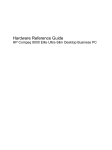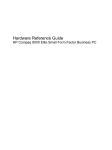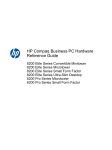Download HP mp8200 Hardware Reference Manual
Transcript
Hardware Reference Guide HP SignagePlayer mp8200, mp8200s © Copyright 2010–2011 Hewlett-Packard Development Company, L.P. The information contained herein is subject to change without notice. Microsoft, Windows, and Windows Vista are either trademarks or registered trademarks of Microsoft Corporation in the United States and/or other countries. The only warranties for HP products and services are set forth in the express warranty statements accompanying such products and services. Nothing herein should be construed as constituting an additional warranty. HP shall not be liable for technical or editorial errors or omissions contained herein. This document contains proprietary information that is protected by copyright. No part of this document may be photocopied, reproduced, or translated to another language without the prior written consent of Hewlett-Packard Company. Hardware Reference Guide HP SignagePlayer mp8200, mp8200s Second Edition (May 2011) First Edition (December 2010) Document part number: 660391-001 About This Book WARNING! Text set off in this manner indicates that failure to follow directions could result in bodily harm or loss of life. CAUTION: Text set off in this manner indicates that failure to follow directions could result in damage to equipment or loss of information. NOTE: Text set off in this manner provides important supplemental information. iii iv About This Book Table of contents 1 Product Features ............................................................................................................... 1 Standard Configuration Features ................................................................................................ 1 Front Panel Components ........................................................................................................... 2 Rear Panel Components ............................................................................................................ 3 Media Card Reader Components ............................................................................................... 4 Keyboard ................................................................................................................................ 5 Using the Windows Logo Key ..................................................................................... 6 Serial Number Location ............................................................................................................ 7 2 Hardware Upgrades ......................................................................................................... 8 Serviceability Features .............................................................................................................. 8 Warnings and Cautions ............................................................................................................ 8 Connecting the Power Cord ...................................................................................................... 9 Removing the Computer Access Panel ....................................................................................... 10 Replacing the Computer Access Panel ...................................................................................... 11 Removing the Front Bezel ........................................................................................................ 12 Removing a Bezel Blank .......................................................................................................... 13 Replacing the Front Bezel ........................................................................................................ 14 Changing from Desktop to Tower Configuration ......................................................................... 15 System Board Connections ...................................................................................................... 16 Installing Additional Memory ................................................................................................... 17 SODIMMs .............................................................................................................. 17 DDR3-SDRAM SODIMMs ......................................................................................... 17 Populating SODIMM Sockets .................................................................................... 18 Installing SODIMMs ................................................................................................ 19 Replacing the Optical Drive ..................................................................................................... 21 Removing the Optical Drive ...................................................................................... 21 Preparing the New Optical Drive .............................................................................. 23 Installing the New Optical Drive ............................................................................... 24 Replacing the Hard Drive ........................................................................................................ 25 Installing and Removing a Port Cover ....................................................................................... 29 v Installing a Security Lock ......................................................................................................... 30 HP/Kensington MicroSaver Security Cable Lock ......................................................... 30 Padlock .................................................................................................................. 31 HP Business PC Security Lock .................................................................................... 31 Front Bezel Security ................................................................................................. 35 Appendix A Battery Replacement ...................................................................................... 37 Appendix B Electrostatic Discharge .................................................................................... 40 Preventing Electrostatic Damage .............................................................................................. 40 Grounding Methods ............................................................................................................... 40 Appendix C Computer Operating Guidelines, Routine Care and Shipping Preparation ........ 41 Computer Operating Guidelines and Routine Care .................................................................... 41 Optical Drive Precautions ........................................................................................................ 42 Operation .............................................................................................................. 42 Cleaning ................................................................................................................ 42 Safety .................................................................................................................... 42 Shipping Preparation .............................................................................................................. 42 Index ................................................................................................................................. 43 vi 1 Product Features Standard Configuration Features Features may vary depending on the model. For a complete listing of the hardware and software installed in the computer, run the diagnostic utility (included on some computer models only). Figure 1-1 Configuration Standard Configuration Features 1 Front Panel Components Drive configuration may vary by model. Some models have a bezel blank covering the optical drive bay. Figure 1-2 Front Panel Components Table 1-1 Front Panel Components 1 Optical Drive 5 Microphone/Headphone Connector 2 Power On Light 6 USB (Universal Serial Bus) Ports 3 SD Media Card Reader (optional) 7 Hard Drive Activity Light 4 Headphone Connector 8 Dual-State Power Button NOTE: When a device is plugged into the Microphone/Headphone Connector, a dialog box will pop up asking if you want to use the connector for a microphone Line-In device or a headphone. You can reconfigure the connector at any time by double-clicking the Realtek HD Audio Manager icon in the Windows taskbar. NOTE: The Power On Light is normally green when the power is on. If it is flashing red, there is a problem with the computer and it is displaying a diagnostic code. Refer to the Maintenance and Service Guide to interpret the code. 2 Chapter 1 Product Features Rear Panel Components Figure 1-3 Rear Panel Components Table 1-2 Rear Panel Components 1 Line-Out Connector for powered audio devices (green) 6 Power Cord Connector 2 PS/2 Keyboard Connector (purple) 7 TV Tuner (optional) 3 Universal Serial Bus (USB) ports 8 Line-In Audio Connector (blue) 4 DisplayPort Monitor Connector 9 PS/2 Mouse Connector (green) 5 VGA Monitor Connector 10 RJ-45 Network Connector NOTE: On some models the optional TV tuner is replaced by an optional wireless antenna. On other models, there are no optional components in this location. When a device is plugged into the blue Line-In Audio Connector, a dialog box will pop up asking if you want to use the connector for a line-in device or a microphone. You can reconfigure the connector at any time by double-clicking the Realtek HD Audio Manager icon in the Windows taskbar. Rear Panel Components 3 Media Card Reader Components The media card reader is an optional device available on some models only. Refer to the following illustration and table to identify the media card reader components. Figure 1-4 Media Card Reader Components Table 1-3 Media Card Reader Components No. Slot Media 1 xD ● xD-Picture Card (xD) 2 MicroSD ● MicroSD (T-Flash) ● MicroSDHC 3 Media Card Reader Activity Light 4 SD/MMC+/miniSD ● Secure Digital (SD) ● MiniSDHC ● ● Secure Digital High Capacity (SDHC) ● MultiMediaCard (MMC) MultiMediaCard 4.0 (MMC Plus) ● MiniSD ● Reduced Size MultiMediaCard (RS MMC) Reduced Size MultiMediaCard 4.0 (MMC Mobile) ● MMC Micro (adapter required) ● 5 USB ● USB (Universal Serial Bus) Port 6 CompactFlash I/II ● CompactFlash Card Type 1 ● CompactFlash Card Type 2 ● MicroDrive 7 MS PRO/MS PRO DUO ● Memory Stick (MS) ● Memory Stick Select ● ● MagicGate Memory Stick (MG) ● Memory Stick Duo (MS Duo) Memory Stick PRO Duo (MS PRO Duo) ● MagicGate Memory Duo ● Memory Stick PRO (MS PRO) Memory Stick PROHG Duo ● Memory Stick Micro (M2) (adapter required) ● 4 Chapter 1 Product Features Keyboard Figure 1-5 Keyboard Components Table 1-4 Keyboard Components 1 1 Function Keys Perform special functions depending on the software application being used. 2 Editing Keys Includes the following: Insert, Home, Page Up, Delete, End, and Page Down. 3 Status Lights Indicate the status of the computer and keyboard settings (Num Lock, Caps Lock, and Scroll Lock). 4 Numeric Keys Work like a calculator keypad. 5 Arrow Keys Used to navigate through a document or Web site. These keys allow you to move left, right, up, and down, using the keyboard instead of the mouse. 6 Ctrl Keys Used in combination with another key; their effect depends on the application software you are using. 7 Application Key1 Used (like the right mouse button) to open pop-up menus in a Microsoft Office application. May perform other functions in other software applications. 8 Windows Logo Keys1 Used to open the Start menu in Microsoft Windows. Used in combination with other keys to perform other functions. 9 Alt Keys Used in combination with another key; their effect depends on the application software you are using. Keys available in select geographic regions. Keyboard 5 Using the Windows Logo Key Use the Windows Logo key in combination with other keys to perform certain functions available in the Windows operating system. Refer to Keyboard on page 5 to identify the Windows Logo key. Table 1-5 Windows Logo Key Functions The following Windows Logo Key functions are available in Microsoft Windows XP, Microsoft Windows Vista, and Microsoft Windows 7. Windows Logo Key Displays or hides the Start menu Windows Logo Key + d Displays the Desktop Windows Logo Key + m Minimizes all open applications Shift + Windows Logo Key + m Undoes Minimize All Windows Logo Key + e Launches My Computer Windows Logo Key + f Launches Find Document Windows Logo Key + Ctrl + f Launches Find Computer Windows Logo Key + F1 Launches Windows Help Windows Logo Key + l Locks the computer if you are connected to a network domain, or allows you to switch users if you are not connected to a network domain Windows Logo Key + r Launches the Run dialog box Windows Logo Key + u Launches the Utility Manager Windows Logo Key + Tab Windows XP - Cycles through the Taskbar buttons Windows Vista and Windows 7 - Cycles through programs on the Taskbar using the Windows Flip 3-D In addition to the Windows Logo Key functions described above, the following functions are also available in Microsoft Windows Vista and Windows 7. Ctrl + Windows Logo Key + Tab Use the arrow keys to cycle through programs on the Taskbar by using Windows Flip 3-D Windows Logo Key + Spacebar Brings all gadgets to the front and select Windows Sidebar Windows Logo Key + g Cycles through Sidebar gadgets Windows Logo Key + t Cycles through programs on the taskbar Windows Logo Key + u Launches Ease of Access Center Windows Logo Key + any number key Launches the Quick Launch shortcut that is in the position that corresponds to the number (for example, Windows Logo Key + 1 launches the first shortcut in the Quick Launch menu) In addition to the Windows Logo Key functions described above, the following functions are also available in Microsoft Windows 7. 6 Windows Logo Key + Ctrl + b Switches to the program that displayed a message in the notification area Windows Logo Key + p Choose a presentation display mode Chapter 1 Product Features Table 1-5 Windows Logo Key Functions (continued) Windows Logo Key + up arrow Maximizes the window Windows Logo Key + left arrow Snaps the window to the left side of the screen Windows Logo Key + right arrow Snaps the window to the right side of the screen Windows Logo Key + down arrow Minimizes the window Windows Logo Key + Shift + up arrow Stretches the window to the top and bottom of the screen Windows Logo Key + Shift + left arrow or right arrow Moves a window from one monitor to another Windows Logo Key + + (on numpad) Zooms in Windows Logo Key + - (on numpad) Zooms out Serial Number Location Each computer has a unique serial number and a product ID number that are located on the top cover of the computer. Keep these numbers available for use when contacting customer service for assistance. Figure 1-6 Serial Number and Product ID Location Serial Number Location 7 2 Hardware Upgrades Serviceability Features The computer includes features that make it easy to upgrade and service. No tools are needed for most of the installation procedures described in this chapter. Warnings and Cautions Before performing upgrades be sure to carefully read all of the applicable instructions, cautions, and warnings in this guide. WARNING! To reduce the risk of personal injury or equipment damage from electrical shock, hot surfaces, or fire: Disconnect the power cord from the power outlet and allow the internal system components to cool before touching. Do not plug telecommunications or telephone connectors into the network interface controller (NIC) receptacles. Do not disable the power cord grounding plug. The grounding plug is an important safety feature. Plug the power cord in a grounded (earthed) outlet that is easily accessible at all times. To reduce the risk of serious injury, read the Safety & Comfort Guide. It describes proper workstation, setup, posture, and health and work habits for computer users, and provides important electrical and mechanical safety information. This guide is located on the Web at http://www.hp.com/ergo. WARNING! Energized and moving parts inside. Disconnect power to the equipment before removing the enclosure. Replace and secure the enclosure before re-energizing the equipment. CAUTION: Static electricity can damage the electrical components of the computer or optional equipment. Before beginning these procedures, ensure that you are discharged of static electricity by briefly touching a grounded metal object. See Electrostatic Discharge on page 40 for more information. When the computer is plugged into an AC power source, voltage is always applied to the system board. You must disconnect the power cord from the power source before opening the computer to prevent damage to internal components. 8 Chapter 2 Hardware Upgrades Connecting the Power Cord When connecting the power supply, it is important to follow the steps below to ensure the power cord does not pull free from the computer. 1. Connect the round end of the power cord to the power supply connector on the rear of the computer (1). 2. Insert the power cord retainer clip into a slot on the air vent to prevent the cord from becoming disconnected from the computer (2). 3. Bundle any excess power cord with the supplied strap (3). 4. Plug the female end of the other power cord into the power supply brick (4). 5. Connect the other end of the power cord to an electrical outlet (5). Figure 2-1 Connecting the Power Cord CAUTION: Failure to secure the power cable with the retainer clip may result in the power cord becoming disconnected and loss of data. Connecting the Power Cord 9 Removing the Computer Access Panel To access internal components, you must remove the access panel: 1. Remove/disengage any security devices that prohibit opening the computer. 2. Remove all removable media, such as compact discs or USB flash drives, from the computer. 3. Turn off the computer properly through the operating system, then turn off any external devices. 4. Disconnect the power cord from the power outlet and disconnect any external devices. CAUTION: Regardless of the power-on state, voltage is always present on the system board as long as the system is plugged into an active AC outlet. You must disconnect the power cord to avoid damage to the internal components of the computer. 5. If the computer is on a stand, remove the computer from the stand and lay the computer down. 6. Loosen the thumbscrew on the rear of the computer (1), slide the access panel toward the rear of the computer, then lift it off (2). Figure 2-2 Removing the Computer Access Panel 10 Chapter 2 Hardware Upgrades Replacing the Computer Access Panel 1. Align the tabs on the panel with the slots on the chassis then slide the panel towards the front of the chassis until it stops (1). 2. Tighten the thumbscrew to secure the access panel (2). Figure 2-3 Replacing the Computer Access Panel Replacing the Computer Access Panel 11 Removing the Front Bezel 1. Remove/disengage any security devices that prohibit opening the computer. 2. Remove all removable media, such as compact discs or USB flash drives, from the computer. 3. Turn off the computer properly through the operating system, then turn off any external devices. 4. Disconnect the power cord from the power outlet and disconnect any external devices. CAUTION: Regardless of the power-on state, voltage is always present on the system board as long as the system is plugged into an active AC outlet. You must disconnect the power cord to avoid damage to the internal components of the computer. 5. If the computer is on a stand, remove the computer from the stand and lay the computer down. 6. Remove the computer access panel. 7. Lift up the three tabs on the side of the bezel (1), then rotate the bezel off the chassis (2). Figure 2-4 Removing the Front Bezel 12 Chapter 2 Hardware Upgrades Removing a Bezel Blank On some models, there is a bezel blank covering the internal drive bay that needs to be removed before installing a drive. To remove a bezel blank: 1. Remove the access panel and front bezel. 2. To remove the bezel blank, push the two retaining tabs that hold the bezel blank in place towards the outer left edge of the bezel (1) and pull the bezel blank inwards to remove it (2). Figure 2-5 Removing a Bezel Blank Removing a Bezel Blank 13 Replacing the Front Bezel Insert the three hooks on the bottom side of the bezel into the rectangular holes on the chassis (1) then rotate the top side of the bezel onto the chassis (2) and snap it into place. Figure 2-6 Replacing the Front Bezel 14 Chapter 2 Hardware Upgrades Changing from Desktop to Tower Configuration 1. Remove/disengage any security devices that prohibit opening the computer. 2. Remove all removable media, such as compact discs or USB flash drives, from the computer. 3. Turn off the computer properly through the operating system, then turn off any external devices. 4. Disconnect the power cord from the power outlet and disconnect any external devices. CAUTION: Regardless of the power-on state, voltage is always present on the system board as long as the system is plugged into an active AC outlet. You must disconnect the power cord to avoid damage to the internal components of the computer. 5. Orient the computer so that its left side is facing down and place the computer firmly down into the stand. Figure 2-7 Placing the Computer on the Stand 6. Reconnect the external equipment, plug the power cord into a power outlet, and turn the computer on. NOTE: Ensure at least 10.2 centimeters (4 inches) of space on all sides of the computer remains clear and free of obstructions. 7. Lock any security devices that were disengaged when the computer cover or access panel was removed. NOTE: An optional Quick Release mounting bracket is available from HP for mounting the computer to a wall, desk, or swing arm. Changing from Desktop to Tower Configuration 15 System Board Connections Refer to the following illustration and table to identify the system board connectors. Figure 2-8 System Board Connections 16 No. System Board Connector System Board Label Color Component 1 SATA 3.0 SATA1 light blue Optical Drive 2 Power SATA PWR1 white Optical Drive 3 Mobile PCI Express Module MXM black Graphics Card 4 Hood Sensor HSENSE white Hood Sensor 5 USB MEDIA black SD Media Card Reader 6 PCI Express x1 X1PCIEXP1 black Expansion Card Chapter 2 Hardware Upgrades Installing Additional Memory The computer comes with double data rate 3 synchronous dynamic random access memory (DDR3SDRAM) small outline dual inline memory modules (SODIMMs). SODIMMs The memory sockets on the system board can be populated with up to two industry-standard SODIMMs. These memory sockets are populated with at least one preinstalled SODIMM. To achieve the maximum memory support, you can populate the system board with up to 8-GB of memory. DDR3-SDRAM SODIMMs CAUTION: This product DOES NOT support DDR3 Ultra Low Voltage (DDR3U) memory. The processor is not compatible with DDR3U memory and if you plug DDR3U memory into the system board, it can cause the physical damage to the SODIMM or invoke system malfunction. For proper system operation, the SODIMMs must be: ● industry-standard 204-pin ● unbuffered non-ECC PC3-8500 DDR3-1066 MHz-compliant or PC3-10600 DDR3-1333 MHzcompliant ● 1.5 volt DDR3-SDRAM SODIMMs The DDR3-SDRAM SODIMMs must also: ● support CAS latency 7 DDR3 1066 MHz (7-7-7 timing) and CAS latency 9 DDR3 1333 MHz (9-9-9 timing) ● contain the mandatory Joint Electronic Device Engineering Council (JEDEC) specification In addition, the computer supports: ● 512-Mbit, 1-Gbit, and 2-Gbit non-ECC memory technologies ● single-sided and double-sided SODIMMS ● SODIMMs constructed with x8 and x16 devices; SODIMMs constructed with x4 SDRAM are not supported NOTE: The system will not operate properly if you install unsupported SODIMMs. Installing Additional Memory 17 Populating SODIMM Sockets There are two SODIMM sockets on the system board, with one socket per channel. The sockets are labeled XMM1 and XMM3. The XMM1 socket operates in memory channel A. The XMM3 socket operates in memory channel B. Figure 2-9 SODIMM Socket Locations Table 2-1 SODIMM Socket Locations Item Description System Board Label Socket Color 1 SODIMM1 socket, Channel B XMM1 Black 2 SODIMM3 socket, Channel A XMM3 Black The system will automatically operate in single channel mode, dual channel mode, or flex mode, depending on how the SODIMMs are installed. 18 ● The system will operate in single channel mode if the SODIMM sockets are populated in one channel only. ● The system will operate in a higher-performing dual channel mode if the memory capacity of the SODIMM in Channel A is equal to the memory capacity of the SODIMM in Channel B. ● The system will operate in flex mode if the memory capacity of the SODIMM in Channel A is not equal to the memory capacity of the SODIMM in Channel B. In flex mode, the channel populated with the least amount of memory describes the total amount of memory assigned to dual channel and the remainder is assigned to single channel. If one channel will have more memory than the other, the larger amount should be assigned to channel A. ● In any mode, the maximum operational speed is determined by the slowest SODIMM in the system. Chapter 2 Hardware Upgrades Installing SODIMMs CAUTION: You must disconnect the power cord and wait approximately 30 seconds for the power to drain before adding or removing memory modules. Regardless of the power-on state, voltage is always supplied to the memory modules as long as the computer is plugged into an active AC outlet. Adding or removing memory modules while voltage is present may cause irreparable damage to the memory modules or system board. The memory module sockets have gold-plated metal contacts. When upgrading the memory, it is important to use memory modules with gold-plated metal contacts to prevent corrosion and/or oxidation resulting from having incompatible metals in contact with each other. Static electricity can damage the electronic components of the computer or optional cards. Before beginning these procedures, ensure that you are discharged of static electricity by briefly touching a grounded metal object. For more information, refer to Electrostatic Discharge on page 40. When handling a memory module, be careful not to touch any of the contacts. Doing so may damage the module. 1. Remove/disengage any security devices that prohibit opening the computer. 2. Remove all removable media, such as compact discs or USB flash drives, from the computer. 3. Turn off the computer properly through the operating system, then turn off any external devices. 4. Disconnect the power cord from the power outlet and disconnect any external devices. CAUTION: You must disconnect the power cord and wait approximately 30 seconds for the power to drain before adding or removing memory modules. Regardless of the power-on state, voltage is always supplied to the memory modules as long as the computer is plugged into an active AC outlet. Adding or removing memory modules while voltage is present may cause irreparable damage to the memory modules or system board. 5. If the computer is on a stand, remove the computer from the stand and lay the computer down. 6. Remove the computer access panel. 7. Locate the memory module sockets on the system board. WARNING! To reduce risk of personal injury from hot surfaces, allow the internal system components to cool before touching. Installing Additional Memory 19 8. To remove a SODIMM, press outward on the two latches on each side of the SODIMM (1) then pull the SODIMM out of the socket (2). Figure 2-10 Removing a SODIMM 9. Slide the new SODIMM into the socket at approximately a 30° angle (1) then press the SODIMM down (2) so that the latches lock it in place. Figure 2-11 Installing a SODIMM NOTE: A memory module can be installed in only one way. Match the notch on the module with the tab on the memory socket. 10. Replace the access panel. 11. If the computer was on a stand, replace the stand. 20 Chapter 2 Hardware Upgrades 12. Reconnect the power cord and turn on the computer. 13. Lock any security devices that were disengaged when the computer cover or access panel was removed. The computer automatically recognizes the additional memory when you turn on the computer. Replacing the Optical Drive The computer uses a slimline Serial ATA (SATA) optical drive. Removing the Optical Drive CAUTION: All removable media should be taken out of a drive before removing the drive from the computer. 1. Remove/disengage any security devices that prohibit opening the computer. 2. Remove all removable media, such as compact discs or USB flash drives, from the computer. 3. Turn off the computer properly through the operating system, then turn off any external devices. 4. Disconnect the power cord from the power outlet and disconnect any external devices. CAUTION: Regardless of the power-on state, voltage is always present on the system board as long as the system is plugged into an active AC outlet. You must disconnect the power cord to avoid damage to the internal components of the computer. 5. If the computer is on a stand, remove the computer from the stand and lay the computer down. 6. Remove the computer access panel and front bezel. Replacing the Optical Drive 21 7. Disconnect the cables on the rear of the optical drive (1), push the green release latch on the right rear side of the drive toward the center of the drive (2), then slide the drive forward and out of the bay through the front bezel (3). CAUTION: When removing the cables, pull the tab or connector instead of the cable itself to avoid damaging the cable. Figure 2-12 Removing the Optical Drive 22 Chapter 2 Hardware Upgrades Preparing the New Optical Drive Before the new optical drive can be used, the release latch must be attached. 1. Peel the backing off the adhesive on the release latch. 2. Without allowing the release latch to touch the optical drive, carefully align the holes on the release latch with the pins on the side of the optical drive. Make sure the release latch is oriented properly. 3. Insert the pin at the front of the optical drive into the hole at the end of the release latch, and press firmly. 4. Insert the second pin, and press the entire release latch firmly to fasten the latch securely to the optical drive. Figure 2-13 Aligning the Release Latch Replacing the Optical Drive 23 Installing the New Optical Drive NOTE: If you are installing an optical drive in a bay that did not previously have a drive in it, you must remove the access panel and the bezel blank covering the opening of the bay before proceeding. Follow the procedures in Removing the Computer Access Panel on page 10 and Removing a Bezel Blank on page 13. 1. Follow the instructions for removing the optical drive. Refer to Removing the Optical Drive on page 21. 2. Attach the release latch to the new optical drive. Refer to Preparing the New Optical Drive on page 23. 3. With the back of the optical drive facing the computer and the release latch on the inner side of the drive, align the drive with the opening in the front bezel. 4. Slide the optical drive through the front bezel all the way into the bay so that it locks in place (1), then connect the cable to the rear of the drive (2). Figure 2-14 Installing the Optical Drive 24 5. Replace the front bezel and access panel. 6. If the computer was on a stand, replace the stand. 7. Reconnect the power cord and turn on the computer. 8. Lock any security devices that were disengaged when the computer cover or access panel was removed. Chapter 2 Hardware Upgrades Replacing the Hard Drive NOTE: The computer supports only 2.5-inch Serial ATA (SATA) internal hard drives. Before you remove the old hard drive, be sure to back up the data from the old hard drive so that you can transfer the data to the new hard drive. The 2.5-inch hard drive is enclosed in a carrier under the optical drive. 1. Remove/disengage any security devices that prohibit opening the computer. 2. Remove all removable media, such as compact discs or USB flash drives, from the computer. 3. Turn off the computer properly through the operating system, then turn off any external devices. 4. Disconnect the power cord from the power outlet and disconnect any external devices. CAUTION: Regardless of the power-on state, voltage is always present on the system board as long as the system is plugged into an active AC outlet. You must disconnect the power cord to avoid damage to the internal components of the computer. 5. If the computer is on a stand, remove the computer from the stand and lay the computer down. 6. Remove the computer access panel. 7. Remove the optical drive. Refer to Removing the Optical Drive on page 21 for instructions. 8. Press in the release latch on the left side of the hard drive carrier (1) then rotate the carrier handle to the right (2). Figure 2-15 Unlocking the Hard Drive Carrier Replacing the Hard Drive 25 9. Lift the hard drive carrier straight up and out of the chassis. Figure 2-16 Removing the Hard Drive Carrier 10. Remove the four guide screws from the sides of the hard drive carrier. Figure 2-17 Removing the Guide Screws 11. Lift the hard drive up to the top of the carrier (1) and slide the drive out of the carrier (2). Figure 2-18 Removing the Hard Drive from the Carrier 26 Chapter 2 Hardware Upgrades 12. Position the hard drive so that the top of the hard drive is up against the top of the carrier (1) so that the circuit board on the bottom of the hard drive does not come in contact wit the tabs on the bottom of the carrier, then slide the new hard drive into the carrier (2). CAUTION: Do not allow the circuit board on the bottom of the hard drive to scrape along the tabs on the bottom of the carrier when sliding the hard drive into the carrier. Doing so can cause irreparable damage to the hard drive. Figure 2-19 Sliding the Hard Drive into the Carrier 13. Set the hard drive down into the bottom of the carrier (1), then replace the four guide screws on the sides of the carrier to secure the drive in the carrier (2). Figure 2-20 Lowering the Hard Drive and Replacing the Guide Screws Replacing the Hard Drive 27 14. To place the hard drive carrier back in the chassis, align the guide screws with the slots on the drive bay, drop the carrier straight down into the drive bay (1), and press the handle on the carrier all the way down (2) so that the drive is properly seated and locked in place. Figure 2-21 Installing the Hard Drive Carrier 15. Replace the optical drive and reconnect the cable on the back of the optical drive. 16. Replace the computer access panel. 17. If the computer was on a stand, replace the stand. 18. Reconnect the power cord and turn on the computer. 19. Lock any security devices that were disengaged when the computer cover or access panel was removed. NOTE: No configuration of the SATA hard drive is necessary; the computer automatically recognizes it the next time you turn on the computer. 28 Chapter 2 Hardware Upgrades Installing and Removing a Port Cover An optional rear port cover is available for the computer. To install the port cover: 1. Thread the cables through the bottom hole on the port cover (1) and connect the cables to the rear ports on the computer. 2. Insert the hooks on the port cover into the slots on the rear of the chassis, then slide the cover to the right to secure it in place (2). Figure 2-22 Installing a Port Cover NOTE: For security purposes, you can install an optional cable lock to the chassis that locks the port cover and secures the computer. See Installing a Security Lock on page 30. The port cover is secured in place by a retention lever just inside the port cover opening. To remove the port cover, pull the lever back towards the port cover opening (1), then slide the cover to the left and off the computer (2). Figure 2-23 Removing a Port Cover Installing and Removing a Port Cover 29 Installing a Security Lock HP/Kensington MicroSaver Security Cable Lock There are two cable lock slots on the rear of the computer. The slot next to the thumbscrew should be used when there is no port cover. The slot on the far right should be used when a port cover is installed. Figure 2-24 Installing a Cable Lock with No Port Cover Figure 2-25 Installing a Cable with a Port Cover Installed 30 Chapter 2 Hardware Upgrades Padlock Figure 2-26 Installing a Padlock HP Business PC Security Lock 1. Fasten the security cable by looping it around a stationary object. Figure 2-27 Securing the Cable to a Fixed Object Installing a Security Lock 31 2. Insert the Kensington lock into the Kensington lock slot on the back of the monitor and secure the lock to the monitor by inserting the key into the key hole on the rear of the lock and rotating the key 90 degrees. Figure 2-28 Installing the Kensington Lock on the Monitor 3. Slide the security cable through the hole in the Kensington lock on the rear of the monitor. Figure 2-29 Securing the Monitor 32 Chapter 2 Hardware Upgrades 4. Use the bracket provided in the kit to secure other peripheral devices by laying the device cable across the center of the bracket (1) and inserting the security cable through one of the two holes in the bracket (2). Use the hole in the bracket that best secures the peripheral device cable. Figure 2-30 Securing Peripheral Devices (Printer Shown) 5. Thread the keyboard and mouse cables through the computer chassis lock. Figure 2-31 Threading the Keyboard and Mouse Cables Installing a Security Lock 33 6. Screw the lock to the chassis in the thumbscrew hole using the screw provided. Figure 2-32 Attaching the Lock to the Chassis 7. Insert the plug end of the security cable into the lock (1) and push the button in (2) to engage the lock. Use the key provided to disengage the lock. Figure 2-33 Engaging the Lock 34 Chapter 2 Hardware Upgrades 8. When complete, all devices in your workstation will be secured. Figure 2-34 Secured Workstation Front Bezel Security The front bezel can be locked in place by installing a security screw provided by HP. To install the security screw: 1. Remove/disengage any security devices that prohibit opening the computer. 2. Remove all removable media, such as compact discs or USB flash drives, from the computer. 3. Turn off the computer properly through the operating system, then turn off any external devices. 4. Disconnect the power cord from the power outlet and disconnect any external devices. CAUTION: Regardless of the power-on state, voltage is always present on the system board as long as the system is plugged into an active AC outlet. You must disconnect the power cord to avoid damage to the internal components of the computer. 5. If the computer is on a stand, remove the computer from the stand. 6. Remove the access panel and front bezel. Installing a Security Lock 35 7. Remove the black screw on the front of the chassis behind the bezel. The screw is located next to the optical drive and is labeled "BEZEL." Figure 2-35 Retrieving the Front Bezel Security Screw 8. Replace the front bezel. 9. Install the security screw through the middle front bezel release tab and into the chassis to secure the front bezel in place. Figure 2-36 Installing the Front Bezel Security Screw 10. Replace the access panel. 11. If the computer was on a stand, replace the stand. 12. Reconnect the power cord and turn on the computer. 13. Lock any security devices that were disengaged when the access panel was removed. 36 Chapter 2 Hardware Upgrades A Battery Replacement The battery that comes with the computer provides power to the real-time clock. When replacing the battery, use a battery equivalent to the battery originally installed in the computer. The computer comes with a 3-volt lithium coin cell battery. WARNING! The computer contains an internal lithium manganese dioxide battery. There is a risk of fire and burns if the battery is not handled properly. To reduce the risk of personal injury: Do not attempt to recharge the battery. Do not expose to temperatures higher than 60°C (140ºF). Do not disassemble, crush, puncture, short external contacts, or dispose of in fire or water. Replace the battery only with the HP spare designated for this product. CAUTION: Before replacing the battery, it is important to back up the computer CMOS settings. When the battery is removed or replaced, the CMOS settings will be cleared. Static electricity can damage the electronic components of the computer or optional equipment. Before beginning these procedures, ensure that you are discharged of static electricity by briefly touching a grounded metal object. NOTE: The lifetime of the lithium battery can be extended by plugging the computer into a live AC wall socket. The lithium battery is only used when the computer is NOT connected to AC power. HP encourages customers to recycle used electronic hardware, HP original print cartridges, and rechargeable batteries. For more information about recycling programs, go to http://www.hp.com/ recycle. 1. Remove/disengage any security devices that prohibit opening the computer. 2. Remove all removable media, such as compact discs or USB flash drives, from the computer. 3. Turn off the computer properly through the operating system, then turn off any external devices. 4. Disconnect the power cord from the power outlet and disconnect any external devices. CAUTION: Regardless of the power-on state, voltage is always present on the system board as long as the system is plugged into an active AC outlet. You must disconnect the power cord to avoid damage to the internal components of the computer. 5. Remove the computer access panel. 37 6. Locate the battery and battery holder on the system board. NOTE: On some computer models, it may be necessary to remove an internal component to gain access to the battery. 7. Depending on the type of battery holder on the system board, complete the following instructions to replace the battery. Type 1 a. Lift the battery out of its holder. Figure A-1 Removing a Coin Cell Battery (Type 1) b. Slide the replacement battery into position, positive side up. The battery holder automatically secures the battery in the proper position. Type 2 a. To release the battery from its holder, squeeze the metal clamp that extends above one edge of the battery. When the battery pops up, lift it out (1). b. To insert the new battery, slide one edge of the replacement battery under the holder’s lip with the positive side up. Push the other edge down until the clamp snaps over the other edge of the battery (2). Figure A-2 Removing and Replacing a Coin Cell Battery (Type 2) 38 Appendix A Battery Replacement Type 3 a. Pull back on the clip (1) that is holding the battery in place, and remove the battery (2). b. Insert the new battery and position the clip back into place. Figure A-3 Removing a Coin Cell Battery (Type 3) NOTE: After the battery has been replaced, use the following steps to complete this procedure. 8. Replace the computer access panel. 9. Plug in the computer and turn on power to the computer. 10. Reset the date and time, your passwords, and any special system setups using Computer Setup. 11. Lock any security devices that were disengaged when the computer access panel was removed. 39 B Electrostatic Discharge A discharge of static electricity from a finger or other conductor may damage system boards or other static-sensitive devices. This type of damage may reduce the life expectancy of the device. Preventing Electrostatic Damage To prevent electrostatic damage, observe the following precautions: ● Avoid hand contact by transporting and storing products in static-safe containers. ● Keep electrostatic-sensitive parts in their containers until they arrive at static-free workstations. ● Place parts on a grounded surface before removing them from their containers. ● Avoid touching pins, leads, or circuitry. ● Always be properly grounded when touching a static-sensitive component or assembly. Grounding Methods There are several methods for grounding. Use one or more of the following methods when handling or installing electrostatic-sensitive parts: ● Use a wrist strap connected by a ground cord to a grounded workstation or computer chassis. Wrist straps are flexible straps with a minimum of 1 megohm +/- 10 percent resistance in the ground cords. To provide proper ground, wear the strap snug against the skin. ● Use heelstraps, toestraps, or bootstraps at standing workstations. Wear the straps on both feet when standing on conductive floors or dissipating floor mats. ● Use conductive field service tools. ● Use a portable field service kit with a folding static-dissipating work mat. If you do not have any of the suggested equipment for proper grounding, contact an HP authorized dealer, reseller, or service provider. NOTE: For more information on static electricity, contact an HP authorized dealer, reseller, or service provider. 40 Appendix B Electrostatic Discharge C Computer Operating Guidelines, Routine Care and Shipping Preparation Computer Operating Guidelines and Routine Care Follow these guidelines to properly set up and care for the computer and monitor: ● Keep the computer away from excessive moisture, direct sunlight, and extremes of heat and cold. ● Operate the computer on a sturdy, level surface. Leave a 10.2-cm (4-inch) clearance on all vented sides of the computer and above the monitor to permit the required airflow. ● Never restrict the airflow into the computer by blocking any vents or air intakes. Do not place the keyboard, with the keyboard feet down, directly against the front of the desktop unit as this also restricts airflow. ● Never operate the computer with the access panel or any of the expansion card slot covers removed. ● Do not stack computers on top of each other or place computers so near each other that they are subject to each other’s re-circulated or preheated air. ● If the computer is to be operated within a separate enclosure, intake and exhaust ventilation must be provided on the enclosure, and the same operating guidelines listed above will still apply. ● Keep liquids away from the computer and keyboard. ● Never cover the ventilation slots on the monitor with any type of material. ● Install or enable power management functions of the operating system or other software, including sleep states. ● Turn off the computer before you do either of the following: ◦ Wipe the exterior of the computer with a soft, damp cloth as needed. Using cleaning products may discolor or damage the finish. ◦ Occasionally clean the air vents on all vented sides of the computer. Lint, dust, and other foreign matter can block the vents and limit the airflow. Computer Operating Guidelines and Routine Care 41 Optical Drive Precautions Be sure to observe the following guidelines while operating or cleaning the optical drive. Operation ● Do not move the drive during operation. This may cause it to malfunction during reading. ● Avoid exposing the drive to sudden changes in temperature, as condensation may form inside the unit. If the temperature suddenly changes while the drive is on, wait at least one hour before you turn off the power. If you operate the unit immediately, it may malfunction while reading. ● Avoid placing the drive in a location that is subject to high humidity, extreme temperatures, mechanical vibration, or direct sunlight. Cleaning ● Clean the panel and controls with a soft, dry cloth or a soft cloth lightly moistened with a mild detergent solution. Never spray cleaning fluids directly on the unit. ● Avoid using any type of solvent, such as alcohol or benzene, which may damage the finish. Safety If any object or liquid falls into the drive, immediately unplug the computer and have it checked by an authorized HP service provider. Shipping Preparation Follow these suggestions when preparing to ship the computer: 1. Back up the hard drive files on PD discs, tape cartridges, CDs, or USB flash drives. Be sure that the backup media is not exposed to electrical or magnetic impulses while stored or in transit. NOTE: The hard drive locks automatically when the system power is turned off. 2. Remove and store all removable media. 3. Turn off the computer and external devices. 4. Disconnect the power cord from the electrical outlet, then from the computer. 5. Disconnect the system components and external devices from their power sources, then from the computer. NOTE: Ensure that all boards are seated properly and secured in the board slots before shipping the computer. 6. 42 Pack the system components and external devices in their original packing boxes or similar packaging with sufficient packing material to protect them. Appendix C Computer Operating Guidelines, Routine Care and Shipping Preparation Index A access panel USDT removal 10 USDT replacement 11 K keyboard components 5 Windows Logo key 6 B battery replacement L locks USDT cable lock 30 USDT front bezel 35 USDT HP Business PC Security Lock 31 USDT padlock 31 37 C computer operating guidelines 41 E electrostatic discharge, preventing damage 40 F front bezel USDT blank removal 13 USDT removal 12 USDT replacement 14 USDT security 35 H hard drive USDT installation 25 USDT removal 25 I installation guidelines 8 installing battery 37 USDT hard drive 25 USDT memory 17 USDT optical drive 24 USDT port cover 29 M media card reader features 4 memory USDT installation 17 USDT socket population 18 USDT specifications 17 O optical drive cleaning 42 precautions 42 USDT installation 24 USDT release latch attachment 23 USDT removal 21 P port cover USDT installation 29 power USDT cord connection product ID locations 7 9 R removing battery 37 USDT bezel blanks 13 USDT computer access panel 10 USDT front bezel 12 USDT hard drive 25 USDT optical drive 21 USDT port cover 29 S security USDT cable lock 30 USDT front bezel 35 USDT HP Business PC Security Lock 31 USDT padlock 31 serial number locations 7 shipping preparation 42 specifications USDT memory 17 system board connections USDT 16 T tower conversion USDT 15 V ventilation guidelines 41 W Windows Logo key 6 Index 43






































































